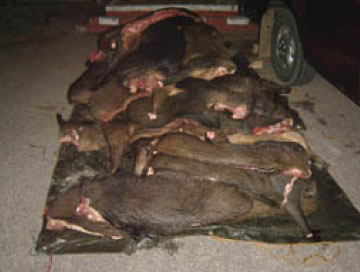THE TIGER
THREATS
Most declining tiger populations are threatened primarily by habitat loss and fragmentation, poaching and wildlife trade, declining prey base and human-tiger conflict.
Poaching and wildlife trade
While habitat protection is essential for the long-term survival of the tiger, illegal trade is a more urgent threat, having the greatest potential to do maximum harm in a short time. Tiger populations have been decimated in many parts of their former range due to illegal hunting for their skin, bones and other body parts.
Throughout Southeast Asia, one of the main threats comes from the trade in tiger parts for use in traditional medicines. Many different cultures use tiger parts for their purported medicinal qualities, including the bones, blood and sexual organs. Bones are the most valuable part of the tiger, more so than the skin. In a number of countries, skin, skull, claws and canine teeth are traded as trophies and talismans, and meat consumed in restaurants serving exotic dishes.
The apprehension of tiger poachers or discovery of poached tigers has been on average less than one case per year, excluding the cases pertaining to the illegal possession of tiger body parts for which the origin is unknown. The actual number is suspected to be higher, but the detection of ’red-handed’ cases is difficult and more realistic figures are not available. Despite the lack of actual figures of tigers poached, it is obvious that tiger poaching continues and is likely to be having an adverse impact on Malaysia’s tiger populations. Tigers are also killed in retaliation to livestock depredation, and it is suspected that some of these conflict tigers also enter the illegal trade.


Habitat loss and fragmentation
Although Malaysia still retains 45% of the land area as forest cover and there are other habitat types that support tigers, the loss of a majority of lowland forests in the last century certainly caused a great decline in the numbers of many large mammals, including the tiger.
In Peninsular Malaysia, where the deforestation rate has stabilised and its main economy has moved from the forestry sector to industry to service, it is not just the loss of habitat but cumulative impacts of forest fragmentation due to construction of roads, pipelines and railways that may impose a greater lasting threat to the tiger. Many of the country’s forest reserves are criss-crossed by logging roads, increasing the potential for extinction in small populations.
Human-tiger conflict
The nature of the tiger and Man means that wherever the homes of both meet or overlap, there is conflict. People compete with the tiger for space and food. Such encounters result in the death of livestock or, in rare but extreme cases, humans. Both lead to the removal of the tiger.
In Malaysia, when conflict events are reported, a DWNP response team is dispatched. Cases of human-tiger conflict in Malaysia, consistently over the years, constitute only around 4% of general human-wildlife conflict incidents. All states with tiger populations are affected by conflict; between 1991 and 2006, 2,398 complaints, including tigers attacking humans, livestock or tigers sighted by villagers, were filed - an average of 160 cases annually. The number of cases reported is in decline (from 355 cases in 1999 to 123 cases in 2006) but the reasons behind this are unknown as data is incomplete.


Declining prey base
The three main prey species are wild pigs, barking deer and sambar deer, also highly sought after by hunters. All protected species can be legally hunted but with a licence from DWNP. There is, however, a high poaching incidence of these species. Some abuse the licences issued and hunt outside the hunting period, exceeding the permitted limit. Others hunt without licences. Poaching also occurs within protected areas.
